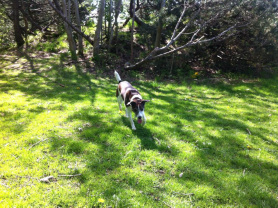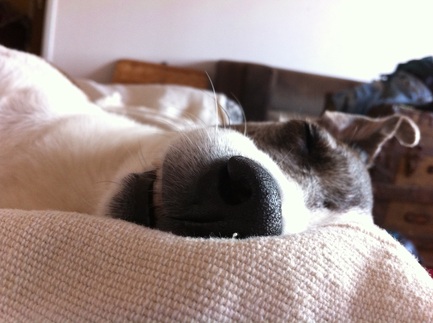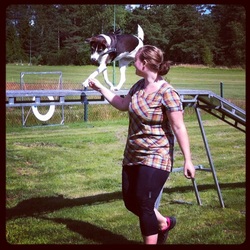There are so many things that I want to put into this blog, as much for my own benefit as for everyone else out there. I find myself thinking about interesting and inspiring topics and end up blending them all together until I'm not sure where I started or where I want to end. Today, though, I decided that I wanted to talk about dog-meetings, a though topic that sometimes means a lot of issues for some owners as well as people.
The title is a line that I have heard from my father-in-law, and I wanted to use that line because I think it's great. He does, in my belief, what I think a lot of us wishes all people could do. He uses this phrase upon seeing a dog he'd like to greet, politely asking permission. It's a wonderful thing I think and a trait more people should use. I'm going to go into the reason why very soon as well, because why you have to ask permission to greet a dog isn't always clear to everyone, and that goes for people without dogs and people with dogs.

Violet says hi!
But, don't all dogs want to say hi? Actually, the truth is a simple no. In today's society, we constantly fill our conscious with imagery, sounds, interactions, musts and dos and don'ts. Some people thrive under the constant movement and excitement but it's a very rare occasion when a dogs do. Together with this and an altered misconception about what a dog should be about and should do and want to do, we can meet a lot of dogs that finds greetings with both people and dogs very stressful. So no, not all dogs want to say hi. In fact, I have a perfect example with this at my work, where the distance given between him and people is a reward. But I love dogs so much! I'm happy to hear you love dogs, I do too. But that also means that I as a knowing adult gives the dog the respect it needs and deserves. So if you really want to say hi to a dog, ask the owner first, because there could be a lot of reasons why you shouldn't and I will mention some of them and they go for everyone, with or without dog. - Training - It's very possible that a dog you meet are doing some form of training. It's very rude to just walk up and interrupt!
- Insecurity and fear - I find that this is the most common reason as to why you shouldn't just walk up to a dog. The reaction could be poorly.
- Aggression - Often based in nr 2, this type of reason almost seems clear to me.
- Dog's not interested - that's right, not all dogs are interested in greeting you, or you and your dog. Dogs are individuals, and they possess traits just like any humans. Some of us don't like the company of others. Same with dogs!
The bottom line here is politeness, towards dogs and its owners. Not all dogs should greet, not all dog want to greet and not every dog is allowed to and this all for different reasons. I've just mentioned a very few of them here, there are surely more but please, think twice before you let your dog up to another dog, or yourself for that matter. Be polite, ask first. It doesn't matter if your dog is the nicest one on the planet, so don't get offended if people tells you no. Their looking after the need of THEIR dog and you should be respectful of that.
Today I received one of the best gifts I can get as a dog-handler.
Although before I get to the good stuff I'm going to need to give you guys a little bit of background. At work, we have a little terrier. He's pretty great with dogs, but people? He doesn't really like people, this little guy. Or, he doesn't like people that gets too close, that goes too far into his personal bubble. He happens to be one of those dogs that needs a REALLY big bubble but sadly a lot of people don't understand this. I was one of those people.
Back when I started at my job, I introduced myself pretty badly to this dog. I was probably too close from the start as well. He carries a lot of insecurities, so meetings with dogs and people is often less than fun for him and he releases the frustration that builds from that insecurity in the shape of barks, lots of barks and stress. In April, I was new and I had an ideology with me that wasn't working very well and I ended up getting bit (guess where that ideology came from). From there on I didn't handle this dog for a while. After the summer holidays we took in an IMMI instructor, who helped us and gave us some tools, among those a form of licking treat. The licking is a great way to relax a stressed mind, the motion of the licking is an instant soothing effect that travels from the muscles of the jaw and directly to the brain. So, that worked really well.
By now I had started to started to think about what I was really doing and what kind of ideology that would work for me and the dogs, all the way through. The terrier responded well to my changed ways and felt alright walking with me. With the licking treat we also formed a small band, which only grew when we started working on balance training, and this for the very reason to help him get better self-confidence.
It's November, and almost December. This dog now chooses to sit in my lap and sniff my face and his tail curls so nicely across his back when we train things enjoys. The past month, we have added tricks and tinkering to his walks that have seemed to help as well. Distance is now a reoccurring reward for not barking, which he loves. The climb has been slow but steady although today something great happened. It showed me that I'm doing the right thin and in the right ways and that it's never too late to make amends and try something new. I think a lot of us instinctively tightens our leash if we know we're about to get into a difficult situation. Me, for one, thought I was helping this dog after stressful situations by shortening the leash and keeping him close and 'safe' as I thought. I tried something new yesterday. No short leash, MORE leash.
I didn't allow myself to pre-build the scenario in my head, but only stayed with loose leash and let him look. Then we walked away. This occurred several time and always very successful. One time there were even 'traffic' from both sides. Today, I did the same thing. Longer leash in general, mixed with contact exercises and rewards for spontaneous contact. Almost back at the daycare, on a lawn he darted forward and grabbed a stick saying
PLAY WITH ME.
He ran around me in circles and it gave me goosebumps. He invited me to play. Which normally does not happen! I cannot describe the feeling but after all those months of work and rebuilding of our bond. Feels awesome.
Best. Thing. Ever.
I know it sounds strange.
Isn't passivity the thing where you do nothing? Yes, it is. Passivity - the trait of remaining inactive.
When I talk about passivity, I am talking about the activity in which we choose to do nothing with our dogs. Not all dogs needs this kind of training, but it's very common that most of dogs needs to exercise passivity in some shape or form. The need and execution of it varies but the goal is always the same - to teach the dog to relax, often at a given moment. For example, at work we work with the dogs to make them realize that during lunch, there will be no activity. That is the moment for them to wind down and maybe have a nap; trust me, it's not always as easy as it sounds.
We've all met the dogs who can though, those who just contently tumbles into the couch after a walk, or just l curls up by your feet during lunch. I love those dogs! We have those kinds of dogs at work and sometimes they are a great influence to some of our other dogs, who has a lot harder time to relax.
I'm going to try and illustrate it with an example from work.
We have chosen at our work to keep the dogs together in rooms. We keep small and big dogs separated and in one of our big dog rooms, we have three flat coated retrievers. Lovely breed, energetic and seemingly insatiable when it comes to activities. We started to notice that particularly one of these ladies was very unhappy being in her room. She barked, howled and wined. For a start, we all agreed on that we were probably not giving her enough activities throughout the day. So for a while we focused on giving all three of them a little extra, to help them wind down and actually be tired at lunch. Sometimes it worked, sometimes not. We tried something new. Still activating them, we were very strict and clear about lunch for them, or so we thought! We told them to lay down, always in the same spots, in hope that this would give a sense of comfort to have the same place but nope, this didn't work entirely either.
Without knowing it, we had not exercises our wished passivity, but created an activity where the dog got a response for a behavior, almost every time, by us getting up from our chairs and telling them to lay down. In this particular case, we achieved our goal by ignoring the dogs and only giving feedback to them when they laid down and were quiet. The reward for the dogs were pebbles of treats and/or coming out to be with us during lunch (not walking around or playing, but laying down close to us).
By activating our dogs 24/7, be in consciously or subconsciously, we are closing in on the risk of overstimulating them and through that creating a mountain of stress. We way to easily teach our dogs to expect activity at every given time or place, but how nice wouldn't it be to say Yes, let's do something! instead of having to tell the dog that No, not happening. Nope, not now either. So, is passivity a dog sleeping in their bed exercising passivity? Could be, but not necessarily. Passivity is often in tight connection with environment training, as we would like for our dog to remain relaxed even in a new environment. If we can help our dogs to understand when we want to them to relax, I believe we'll get a more balance dog. It's a humongous stress for a dog to at all times expect that something is going to happen and I'm certain frustration rooted in all this expectation won't help either.
Your dog is an individual and with a personality that deserves to be respected and taken seriously, meaning everyone of them is different. You have to find what fits your dog and go on from there.
 Fellie, or Ofelia. Fellie, or Ofelia. Alright.
I guess, first off, thanks for reading this and welcome as well to this new, shiny blog that I hope I will conduct in a safe and educational way. The dog on the picture here is Fellie, one of my rescue dogs that I took in. You'll be seeing her a lot as far as pictures goes and right now she's living a full and wonderful life in her forever-home.
Alright, so let's start with the easy part and that is the butt of the word - Maa. I've had an online alias for a long time, and it's been Maalin and therefor the two a's at the end of this blog. Now the second part:
Dogma - is a principle or set of principles laid down by an authority as incontrovertibly true. It serves as part of the primary basis of an ideology or belief system, and it cannot be changed or discarded without affecting the very system's paradigm, or the ideology itself.
My deal with the choosing of my name has a lot to do with the above and I will try to explain why. The dogworld is a big one and currently its fluctuating with about a million different methods when it comes to dogs; how you treat them, behave around them and with them, how you train them. Why how and when to deal with aggression and behavioral-issues. There's not only a single method or series of principles with dogs, there are about a hundred and while that is a good thing, all of us connected to dogs in any shape, way or form, lack one important thing. And that's an ideology and moral that we can all stand for. We are missing a unity in the most basic of forms. That's why I named my blog DogMaa, because I want to be a part of forming the future dogma for everyone within distance of a dog, working with dogs or owning a dog. We are ALL the authority here and we just need to come together under the flag of the ship, and the thing I think everyone wants with their dog - a good relationship.
Without this core and foundation, we can't move on, unless we do it by force and that spells out badly for everyone.
Think about it.
Working in a doggy daycare, I've had time to think about this a lot. Every time I find myself in a situation where I get annoyed or feel like strangling a dog (hey, we're only human) I remind myself that this is not my dog but even more importantly, I ask myself every time what kind of relationship do I want with this dog? A good one, is always the answer. It makes me think twice about what I am doing in that very moment and if I should be doing it in the first place, meaning I pick my moments with the dogs. It's harder to step to the side when you're out walking with a dog but instead of doing that tug or yank on the leash or tell them in a displeased voice that they did something you didn't like--but you always have the choice to show the dog what you want instead. Everything boils down to what kind of relationship you do want with the dog.
|




 RSS Feed
RSS Feed